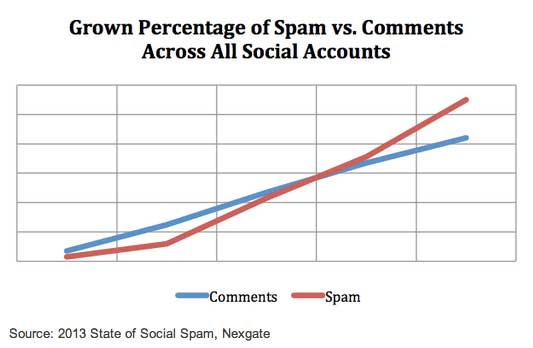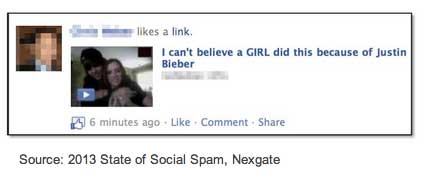From January to June of 2013, there was a 355% growth of spam to the typical social media account, according to a recent study by Nexgate.
The report, which was based on an analysis of 60 million pieces of unique content written by over 25 million social accounts, found that there has been a significant increase in both the amount of social spam and in the number of ways that it is distributed.
Simple text- and link-based posts were found to be the most popular types of social media spam, while "Like-jacking," social bots, fake accounts, and "spammy apps" were the most prevalent forms of distribution.
Nexgate estimates that one out of every 200 social media messages now contains spam—including lures to adult content, malware, and get-rich-quick schemes. The analysis also found increased growth in "spamdexing" (posting links to legitimate websites from spammy accounts in order to boost the sites in search results).
Overall, the analysis found that the rate of spam is now growing faster than the rate of comments on social networks.

Below, additional key findings from the report.
Spam by Network
- Nexgate found that Facebook and YouTube contain the most spam content compared with other social media networks.
- Facebook had the highest number of phishing attacks seeking personally identifiable information—more than four times the other social media networks.
Fake Profiles
- Spammers often post from as many as 23 different social media accounts, according to the analysis.
- Activity from these fake accounts is quite different from the activity seen by real accounts. Fake profiles usually post high volumes of content in just a few days, whereas real profiles tend to post content consistently over time.

Spammy Apps and Like-Jacking
- "Spammy apps" and "Like-jacking" are increasingly popular forms of social media spam distribution according to the report.
- Spammy apps offer to perform special tasks that a typical social media platform is unable to do, such as determining the number of profile views. Once these apps are installed, malicious software or phishing attacks can exploit the victim.
- Nexgate found that 5% of all social media apps are now spammy.
- With Like-jacking, instead of clicking on links, victims are tricked into clicking on images that appear as "Likes" or other buttons that are typically harmless. The victim is then either taken to a website hosted by a spammer, or the liked content can simply appear at the top of their news feed.

About the research: The study was based on data collected from social media networks between 2011 and 2013. The networks examined were Facebook, Twitter, Google+, YouTube, and LinkedIn. The data set included 60 million pieces of unique content written by over 25 million social accounts.




